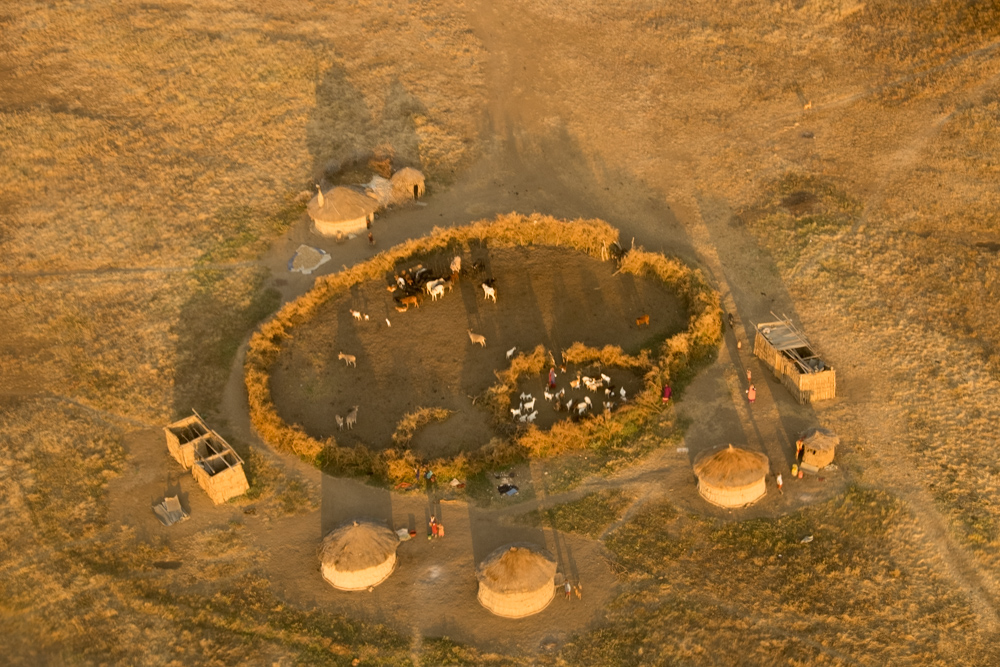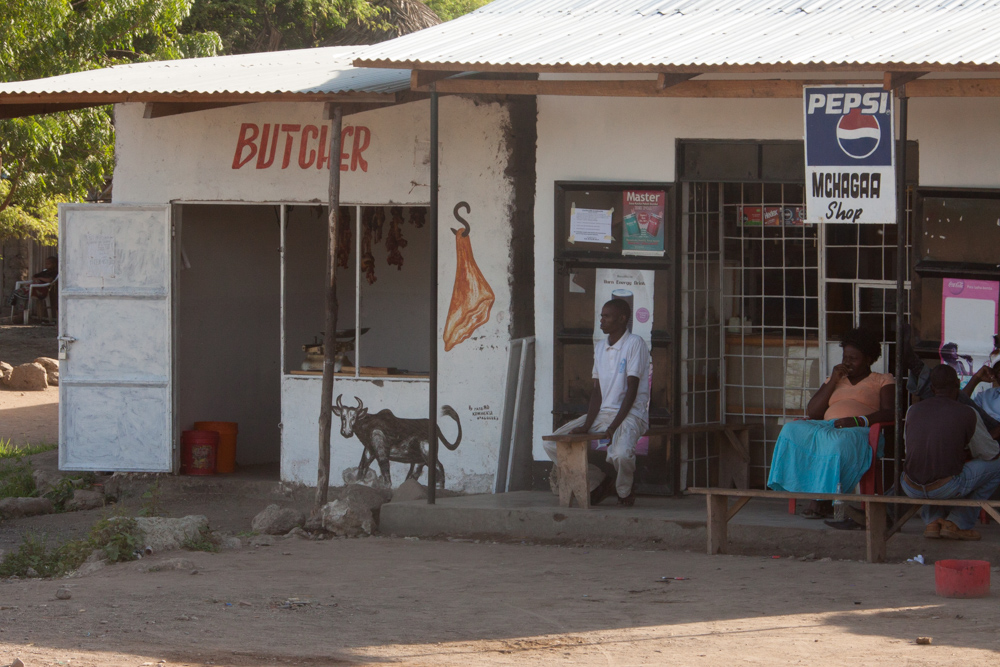When I was a boy in the 1970s giraffes used to feed on the leaves of a fever tree outside my window. Our dogs had to watch out for warthog who were often in the garden. We would hear hyaenas whooping and lions roaring at night.
I remember cycling to the nearest shop to buy glue and patches to repair a puncture. The road skirted the edge of Nairobi National Park (a wildlife reserve) and after 3 kilometres it crossed the Mbagathi River. From here onwards there were no fences, and aside from two or three tin roofed dukas (shops), and an open space for a weekly cattle market, the only houses were those in Maasai enkangs (a village or thorn fenced enclosure with collection of small mud domed homes, one for each adult woman. The enclosure is to keep out lions and other marauding animals). Maasai alone lived in this area, herding their livestock, often near herds of wildebeest, zebras and gazelles.
In those years during the Christmas holidays we used to drive 500 kilometres to Mombasa, on the coast, where we stayed with my grandparents. The journey seemed to last for ever. There were some farms and a few villages, but we mostly passed through dry unfenced country. My brother, sister and I would pile onto a mattress in the back of the station wagon and play, argue, fight and spot (point out) wildlife for most of the way. We used to stop for lunch at Mtito Andei. From there to the coast we would always have to slow down or stop for elephants and other animals crossing the road. Once or twice we would detour and spend a night in Tsavo National Park to break the journey. We had to watch out for rhinoceros. We were charged once. A journey anywhere in Kenya involved seeing wildlife from the road. Interestingly elephants in Kenya in the 1970s were in decline. This was a period of massive elephant poaching for ivory, although at the time there seemed to be elephants everywhere.
From 9-14 years of age I went to boarding school in England. I used to fly from Nairobi to London 4-6 times a year. This was a huge culture shock for me. The flight from Kenya usually left in the late afternoon and took all night and some of the following morning. The cabin would smell of tobacco smoke. It was hard to sleep and I usually woke up before dawn. I would look out of the window and see the stars glinting like crystals. The vast shadow of the Sahara Desert would still be spread out below me. Later I would see a thin series of lights resembling glass beads on a necklace. Then they would disappear, leaving an inky blackness below us as we crossed the Mediterranean Sea. Next I could see more lights approaching in the distance, but this time lots of them. They twinkled and were so many that they traced shapes of valleys, mountains and coastlines. Arteries of moving lights indicated the highways. Over these few years I came to recognise these as the shapes that I had seen on maps of Sicily and the heel of Italy. I would be astounded by the number of the lights.
When the plane descended through the English fog and landed on the wet runway, I was in a different world. The air smelled cold, damp, and contained a touch of oak blended with petrol. I thought that the English all spoke like they did on the BBC, but when I got there it was hard to understand the taxi drivers. Nearly everyone was white! I never saw a dirt road. All the roads were tarmac and most had street lights. A list of surprises and contrasts would be long. Although I got used to these journeys, each time I arrived in England the contrast seem to be accentuated rather than diminished, and I would notice all the differences as if for the first time.
England signified people, cities, roads, lights, and damp. Africa was space, sun, dust, wildlife, a vibrancy in the air, and a sense of simplicity or lack of wastefulness. That is not surprising. Kenya´s human population was then about 14 million. The United Kingdom, about half the area, had a population of about four times that of Kenya. When I was 14 I went to a different school back in Kenya. Memories of England faded but never disappeared.
I left four years later and moved around for almost nine years before I returned to East Africa to settle for a while. Kenya´s population had risen to over 23 million by 1990, and was noticeably busier than before. Like most of Africa this growth is almost entirely due to the increased birth rate and a longer mean life expectancy, and not migration. Kenya does have refugees and immigrants, but they are a similar number to the number of people who have emigrated, resulting in a near zero effect on the overall population numbers.
I then worked with my brother in neighbouring Tanzania, a country almost twice a large as Kenya. Tanzania was just opening up after a long bout of Communism. Literacy had increased, and there was little disparity in wealth, but life was pretty tough for many. Its human population was growing at a much slower pace. In 1990 it was about the same as Kenya. I had a wonderful time in Tanzania, and lived there for almost twenty years. During this time a huge transition occurred as the economy boomed, and a more educated middle class arose. However, the human population had almost doubled to reach 45 million. Twelve years later Kenya´s population reaches 54 million, and Tanzania´s overtakes Kenya to become 60 million.
The reason for this article was not to impress upon you my childhood, but to give a sense of how impactful environmental differences between Europe and Africa, and changes in the same places over time have had on me.
It is hard to emphasise how strong these have been. I hope that descriptions of my childhood may give you an idea what it was like when I was young, and how different it is now. All of these differences are attributable to us. They are what we have created. Had we simply had less children everything including the economy, resources available to us, standards of living and our environment would be different. David Attenborough´s outstanding programs on wildlife and on our impact in nature, and his emphasis on how our world is so gravely threatened are so poignant.
The country where I was born is the same one today, but it has changed to the point of almost being unrecognisable in those fifty years.
In 1960 Kenya was still a British colony, with about 7 million inhabitants. Since then opportunities and rights have improved. The economy has also boomed, along with availability of health care, education, and life expectancy. Those living in sprawling urban slums today have no field or second home in the country any more. Those pieces of land that were so useful when there was no work have long since been subdivided and sold to others.
The two or three shops where I bought the puncture repair items are no longer there. That area is part of a dormitory suburb of Nairobi called Ong’ata Rongai. It houses about half the number of people as the whole of Nairobi did in 1960 (Nairobi´s population was 300,000 then, and today it is about 5 million). There are supermarkets, bars, churches and banks. Unless it rains, a measly trickle of water flows in this section of the Mbagathi River.
There are no rhinos in that area near the road to Mombasa any more. Luckily huge efforts have been made to protect the black rhinoceros (the only species indigenous to this area), and they are still around in a handful of protected reserves.
As a child living in Kenya I took the wildlife I saw around me for granted. I realised this was not universal when I went to school in Europe. I later witnessed the decline in wildlife when I returned after periods of being away.
Data on wildlife populations is limited prior to the 1960s. According to a paper written by scientist Iain Douglas-Hamilton
Carcass ratios from surveys conducted across the range-lands by the Kenya rangeland monitoring unit suggest declines of the order of 80 per cent prior to 1981. Kenya’s most important elephant population, in the Tsavo National Park, probably numbered well over 40,000 in the late 1960s.
African Elephants: Population Trends and Their Causes by Iain Douglas-Hamilton (1987)
An aerial survey conducted in the larger Tsavo ecosystem in 2011 (Status and trends of the elephant population in the Tsavo-Mkomazi Ecosystem_Ngene et al 2013.pdf) counted 12,500 elephants.
Interestingly recently there has been news of the elephant populations more than doubling in Kenya. The data in that and a similar article compares elephant populations over the previous twenty years, and does not take into account earlier periods when they had a lot more space to wander. Elephant populations can never get back to levels of the 1960s.
Kenya is renowned for its wildlife, but the populations of wildlife and natural habitats have overall been in decline, as described in this news article. A list comparing population numbers of select species between two periods, the late 70s (1977-1980) and the early 2010s (2011-2013) a little over 20 years later, shows this decline: warthog 30,726 vs 8,676, Thomson’s gazelle 158,452 vs 38,989, eland 447,145 vs 9,826, hartebeest 42,977 vs 6,837, impala 171,016 vs 27,124, and waterbuck 15,619 vs 1,906. This was from a paper written by Joseph O. Ogutu and colleagues and published in 2016 (titled Extreme Wildlife Declines and Concurrent Increase in Livestock Numbers in Kenya: What Are the Causes?). The document lists seven causes of reduction in wildlife numbers in order of priority – and states that The first cause of the declines is rapid human population growth.
The reason for this decline is clear. Kenya now has about 55 million people, and is projected to have about 67 million in 2030! That is over a sevenfold increase since 1960! The problem of human population growth is immense.
The human population of Tanzania has grown sixfold from 10 million in 1960 to over 60 million today, and is projected to reach 100 million by 2038. Yet the current president John Magufuli thinks that women should be encouraged to have more children!
I was acutely aware of this problem before I left Kenya in 1980. The Kenya Government had access to this information for a long time. The Institute for Development Studies at the University of Nairobi had published a report on population growth in 1974. The United Nations and world leaders have been aware of this too. Sadly population growth had been and still is a taboo subject in international circles, and very little has been done.
There are several reasons for this becoming taboo, and I will write about those and suggested solutions to the population anobis separately.
Sadly, taboo or not, if we do not address human population growth as one of the primary reasons for our current anobis, Nature will. In fact the recent Covid-19 pandemic is an indirect result of the same issue.



